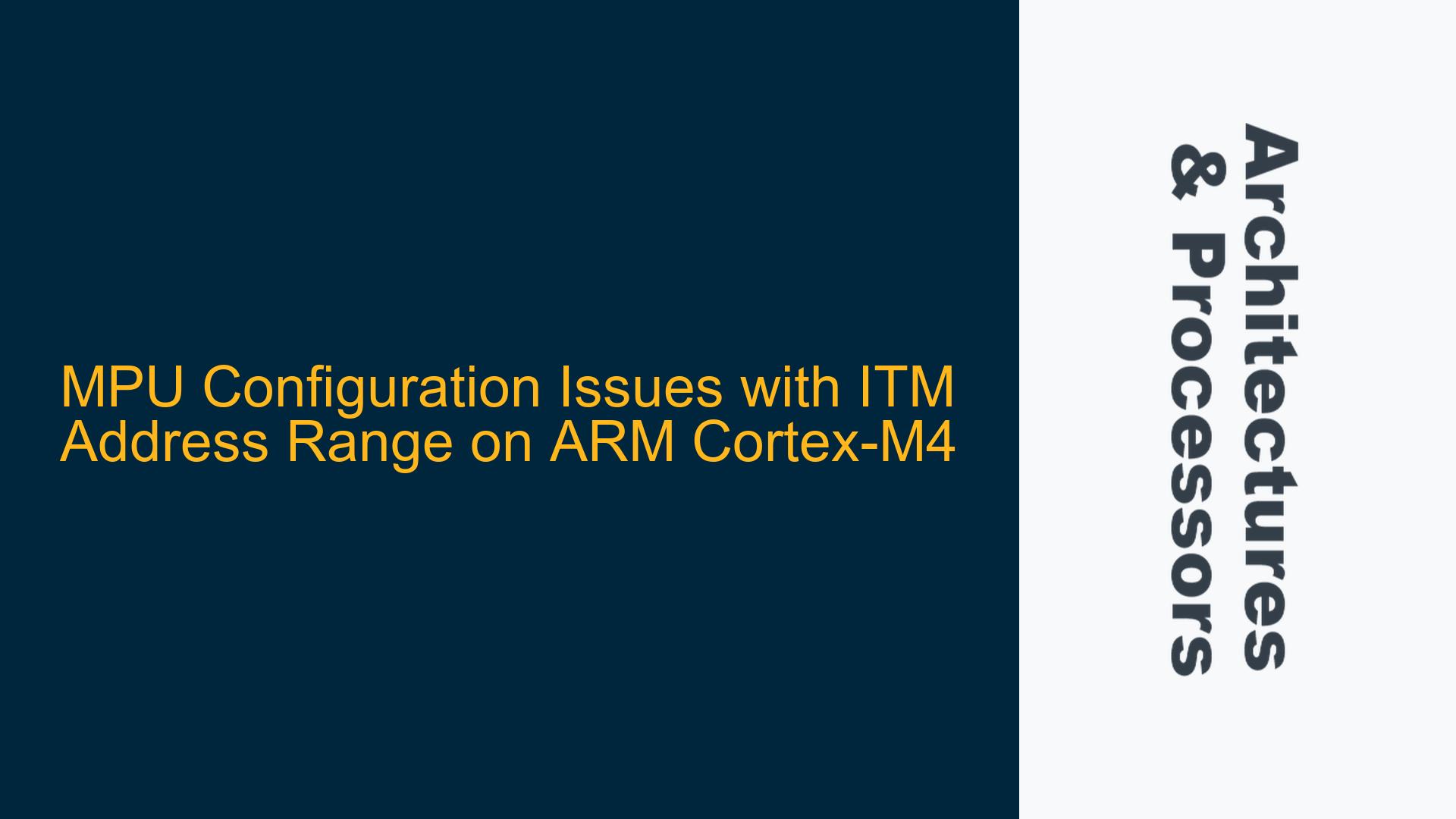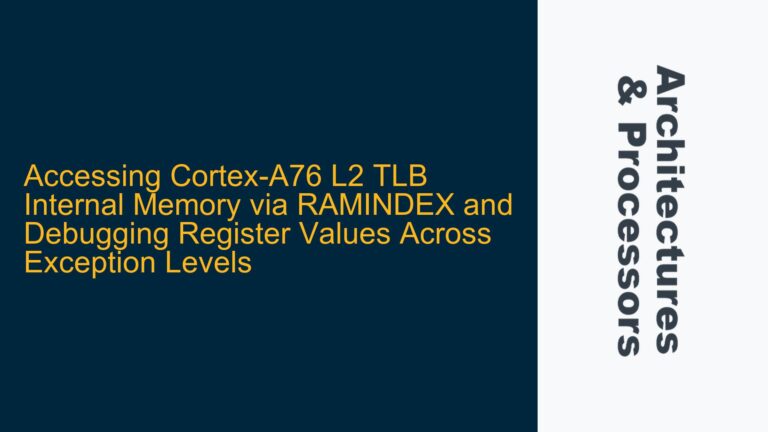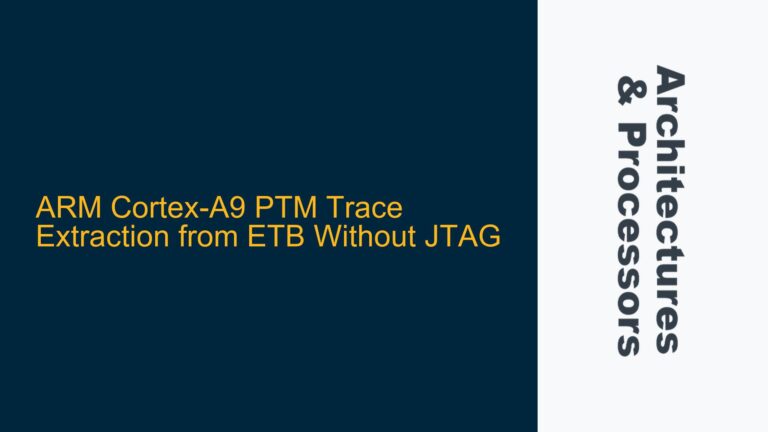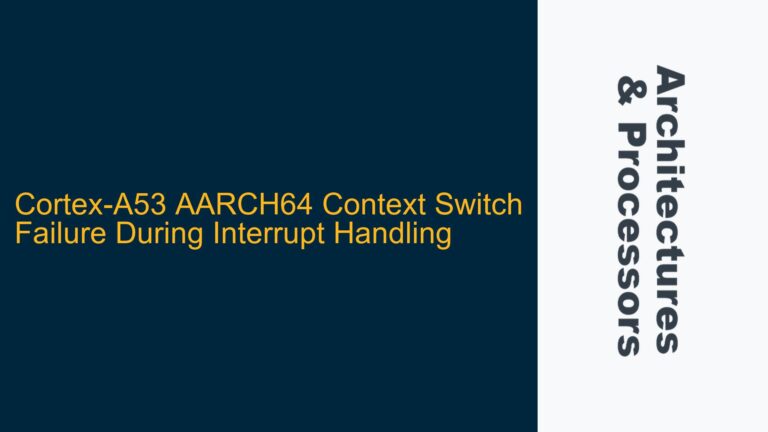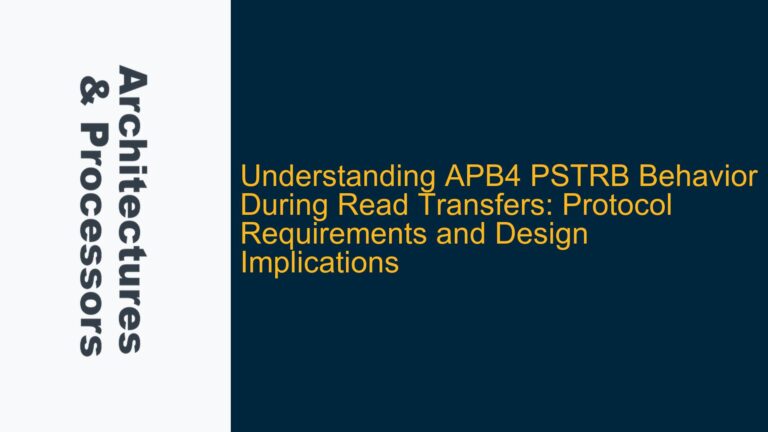MPU Enforcement Failure in ITM Address Space (0xE0000000 – 0xE0010000)
The Memory Protection Unit (MPU) on the ARM Cortex-M4 is designed to enforce memory access permissions and attributes for different regions of the address space. However, when configuring the MPU to restrict access to the Instrumentation Trace Macrocell (ITM) address range (0xE0000000 – 0xE0010000), unprivileged threads are still able to read from this region despite the MPU settings. This behavior is inconsistent with the expected MPU enforcement, which works correctly for other peripheral address ranges. The issue is particularly noticeable when the MPU is configured to allow only privileged access to the entire peripheral address space, including the ITM region. The problem manifests as follows:
- For addresses below 0xE0000000, the MPU correctly enforces privileged access, preventing unprivileged threads from accessing the memory region.
- For addresses between 0xE0000000 and 0xE0010000 (the ITM address range), unprivileged threads can still read from this region, bypassing the MPU restrictions.
- For addresses between 0xE0010000 and 0xE0100000, a bus fault occurs, indicating that the MPU is enforcing access restrictions but not as intended.
- For addresses above 0xE0100000, the MPU works as expected, enforcing privileged access.
This behavior suggests that the MPU’s enforcement mechanisms are either being overridden or are ineffective for the ITM address range. Understanding the root cause of this issue requires a deep dive into the ARM Cortex-M4 architecture, the MPU’s interaction with the default memory map, and the specific behavior of the ITM.
Default Memory Map Constraints and MPU Limitations
The ARM Cortex-M4 architecture defines a default memory map that includes specific regions with fixed attributes. These attributes cannot be modified by the MPU, which imposes certain limitations on how the MPU can enforce access permissions. The key constraints relevant to this issue are:
-
System Space Attributes: The system space, which includes addresses from 0xE0000000 and higher, is always marked as Execute Never (XN). This means that code execution is prohibited in this region, regardless of MPU settings. The XN attribute is hardwired and cannot be overridden by the MPU.
-
Private Peripheral Bus (PPB) Access: The PPB, which spans from 0xE0000000 to 0xE00FFFFF, always uses the default system address map. This means that the MPU cannot modify the access permissions or attributes for this region. The PPB includes critical system peripherals such as the Nested Vectored Interrupt Controller (NVIC), System Control Block (SCB), and the ITM.
-
Exception Vector Reads: Reads to the exception vector table always use the default system address map. This ensures that the processor can always access the exception vectors, even if the MPU is configured to restrict access to the memory region containing the vectors.
-
ITM Behavior: The ITM, which is part of the PPB, has specific behavior regarding access permissions. If the ITM is disabled or not implemented, writes to the stimulus ports must not cause a bus fault. This ensures that the ITM is transparent to application software. Additionally, the Trace Privilege Register (TPR) defines whether unprivileged code can write to the stimulus ports. However, unprivileged code can always read the stimulus ports, regardless of the TPR settings.
These constraints explain why the MPU cannot enforce privileged access for the ITM address range. The default memory map attributes and the specific behavior of the ITM take precedence over the MPU settings, allowing unprivileged threads to read from the ITM region.
Resolving MPU Enforcement Issues with ITM Address Range
To address the MPU enforcement issues with the ITM address range, it is necessary to understand the limitations imposed by the ARM Cortex-M4 architecture and implement workarounds that achieve the desired access control. The following steps outline the troubleshooting process and potential solutions:
-
Verify MPU Configuration: Ensure that the MPU is correctly configured to enforce privileged access for the entire peripheral address space, including the ITM region. This involves setting the appropriate base address, size, access permissions, and attributes for the MPU region covering the ITM address range. The MPU region should be configured as follows:
- Base Address: 0xE0000000
- Size: 1 MB (to cover the entire PPB)
- Access Permissions: Privileged access only
- Attributes: Device memory type, Execute Never (XN)
-
Check Default Memory Map Constraints: Recognize that the MPU cannot override the default memory map attributes for the PPB, including the ITM region. This means that the MPU settings for the ITM address range will not be fully effective, and unprivileged threads will still be able to read from the ITM stimulus ports.
-
Use Trace Privilege Register (TPR): To control access to the ITM stimulus ports, use the TPR to define whether unprivileged code can write to the stimulus ports. While the TPR does not restrict reads, it can be used to prevent unprivileged code from modifying the ITM state. The TPR can be configured as follows:
- Set the appropriate bits in the TPR to disable unprivileged writes to the stimulus ports.
- Ensure that the TPR is configured early in the initialization sequence, before any unprivileged code attempts to access the ITM.
-
Implement Software-Based Access Control: If strict access control is required for the ITM region, implement software-based checks to prevent unprivileged code from accessing the ITM. This can be done by:
- Adding checks in the application code to verify the privilege level before accessing the ITM.
- Using exception handlers to catch and handle unauthorized access attempts to the ITM region.
-
Consider Alternative Debugging Mechanisms: If the ITM is not essential for the application, consider using alternative debugging mechanisms that do not rely on the ITM. This can include using the Serial Wire Output (SWO) or other trace mechanisms that are not subject to the same access control limitations.
-
Consult MCU-Specific Documentation: Review the STM32F429 documentation to determine if there are any MCU-specific constraints or features that affect the MPU’s behavior with the ITM address range. Some MCUs may have additional restrictions or workarounds that can be leveraged to achieve the desired access control.
By following these steps, it is possible to mitigate the MPU enforcement issues with the ITM address range and achieve a more secure and reliable system implementation. While the ARM Cortex-M4 architecture imposes certain limitations, understanding these constraints and implementing appropriate workarounds can help ensure that the system behaves as intended.
Detailed Analysis of MPU and ITM Interaction
To further understand the interaction between the MPU and the ITM, it is necessary to delve into the architectural details of the ARM Cortex-M4 and the specific behavior of the ITM. The following sections provide a detailed analysis of the relevant components and their interactions.
Memory Protection Unit (MPU) Overview
The MPU is a programmable unit that allows the system to define memory regions with specific access permissions and attributes. The MPU is typically used to enforce memory protection, isolate different tasks, and prevent unauthorized access to critical memory regions. The key features of the MPU include:
- Region Configuration: The MPU allows the definition of up to 8 or 16 memory regions (depending on the implementation), each with a base address, size, access permissions, and attributes.
- Access Permissions: Each MPU region can be configured to allow or restrict access based on the privilege level (privileged or unprivileged) and the type of access (read, write, execute).
- Attributes: The MPU allows the configuration of memory attributes such as cacheability, shareability, and execute never (XN).
The MPU operates in conjunction with the default memory map, which defines the attributes and access permissions for the entire address space. The MPU can override some of the default attributes, but certain regions, such as the PPB, have fixed attributes that cannot be modified.
Instrumentation Trace Macrocell (ITM) Overview
The ITM is a debugging component that provides real-time trace capabilities for the ARM Cortex-M4. The ITM allows the application to generate trace messages that can be captured and analyzed by a debugger. The key features of the ITM include:
- Stimulus Ports: The ITM provides 32 stimulus ports that can be used to generate trace messages. Each stimulus port is associated with a 32-bit register that can be written by the application.
- Trace Enable Register: The ITM includes a Trace Enable Register that controls whether each stimulus port is enabled or disabled.
- Trace Privilege Register (TPR): The TPR defines whether unprivileged code can write to the stimulus ports. The TPR also controls whether unprivileged code can read the Trace Enable Register.
The ITM is part of the PPB, which means that it is subject to the default memory map constraints. Specifically, the ITM address range (0xE0000000 – 0xE0010000) is always marked as Execute Never (XN), and the access permissions are determined by the default memory map and the TPR.
Interaction Between MPU and ITM
The interaction between the MPU and the ITM is governed by the default memory map constraints and the specific behavior of the ITM. The following points highlight the key aspects of this interaction:
-
Default Memory Map Constraints: The PPB, including the ITM, is always subject to the default memory map attributes. This means that the MPU cannot modify the access permissions or attributes for the ITM address range. Specifically, the ITM region is always marked as Execute Never (XN), and the access permissions are determined by the default memory map.
-
Trace Privilege Register (TPR): The TPR allows the system to control whether unprivileged code can write to the ITM stimulus ports. However, the TPR does not restrict reads from the stimulus ports. This means that unprivileged code can always read from the ITM stimulus ports, regardless of the MPU settings.
-
MPU Enforcement Limitations: The MPU cannot enforce privileged access for the ITM address range because the default memory map constraints take precedence. This results in the observed behavior where unprivileged threads can still read from the ITM region, even when the MPU is configured to restrict access.
Practical Implications and Workarounds
Given the limitations imposed by the ARM Cortex-M4 architecture, it is important to understand the practical implications and implement appropriate workarounds to achieve the desired access control. The following sections discuss the practical implications and potential workarounds.
Practical Implications
-
Unprivileged Access to ITM: The inability of the MPU to enforce privileged access for the ITM address range means that unprivileged code can always read from the ITM stimulus ports. This can be a security concern if the ITM is used to generate sensitive trace messages.
-
Debugging Transparency: The ITM is designed to be transparent to application software, meaning that writes to the stimulus ports must not cause a bus fault if the ITM is disabled or not implemented. This ensures that the application can continue to function even if the ITM is not used.
-
System Security: The default memory map constraints and the behavior of the ITM can impact the overall security of the system. It is important to consider these constraints when designing the system and implementing access control mechanisms.
Potential Workarounds
-
Software-Based Access Control: Implement software-based checks to prevent unprivileged code from accessing the ITM. This can be done by adding privilege level checks in the application code before accessing the ITM stimulus ports.
-
Use of Trace Privilege Register (TPR): Configure the TPR to disable unprivileged writes to the ITM stimulus ports. While this does not restrict reads, it can prevent unprivileged code from modifying the ITM state.
-
Alternative Debugging Mechanisms: Consider using alternative debugging mechanisms that do not rely on the ITM. This can include using the Serial Wire Output (SWO) or other trace mechanisms that are not subject to the same access control limitations.
-
System Design Considerations: When designing the system, consider the limitations of the MPU and the behavior of the ITM. Ensure that the system is designed to handle the potential security implications of unprivileged access to the ITM.
Conclusion
The MPU enforcement issues with the ITM address range on the ARM Cortex-M4 are a result of the default memory map constraints and the specific behavior of the ITM. While the MPU is a powerful tool for enforcing memory access permissions, it has limitations when it comes to the PPB and the ITM. Understanding these limitations and implementing appropriate workarounds is essential for achieving a secure and reliable system implementation. By following the troubleshooting steps and solutions outlined in this guide, it is possible to mitigate the MPU enforcement issues and ensure that the system behaves as intended.
